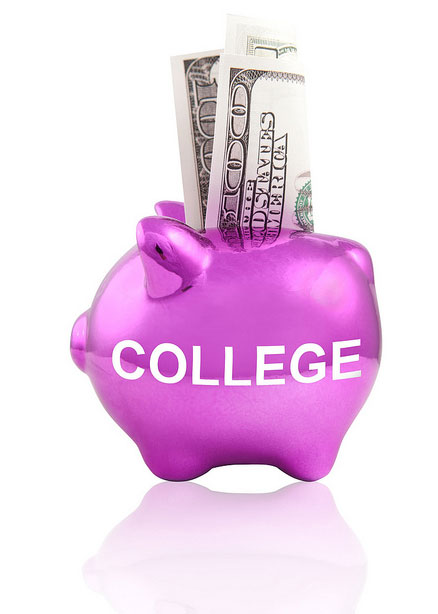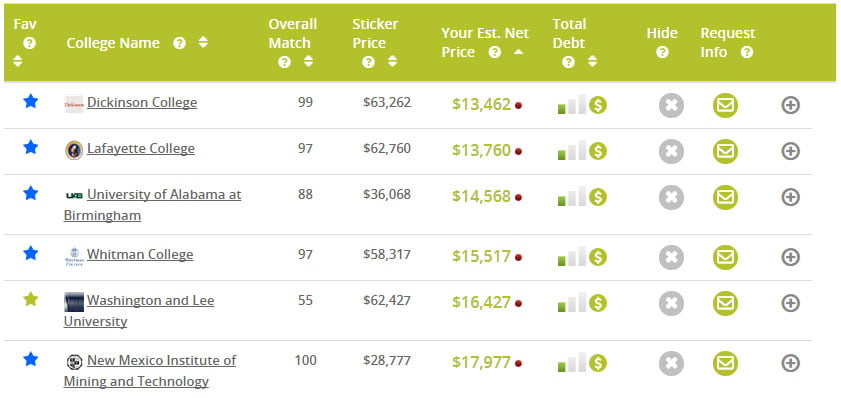For many middle class families, applying for financial aid can seem like a cruel joke.

Source: Flickr user 76657755@N04.
You earn too much money to receive financial aid, but you don’t earn enough to write a check for college. Sound familiar?
You’re not alone.
But, don’t worry–there are options out there for you. I promise!
College Raptor was designed to solve this exact problem–help match students with colleges that are not only a good academic and cultural fit but are also likely to meet their financial needs.
Our team has spent hundreds of hours collecting and analyzing data on college costs and financial aid. And, while each student and family scenario is unique, there are some strategies you can use to maximize the potential financial aid your student will receive. Thus reducing costs and reducing the amount your student will need to borrow in student loans.
Here are some tips for your quest to find the right college at the right price:
1. Invest in academics to earn more merit aid
One of the best ways for middle-class students to earn better financial aid is to simply have a stronger academic record. Higher GPAs and ACT or SAT scores can pay off in a huge way. Even an improvement of just a few points on the ACT could mean the difference between $5,000 and $10,000 in merit scholarships.
So, one way to get better financial aid could be to invest in tutoring or test prep courses for your student. This relatively small investment could earn your student a significant amount of additional financial aid and often makes a bigger impact than playing sports or instruments.
The College Raptor “What If” tool (found on the College Match results screen) estimates how changes in your student’s grades and test scores will not only impact their acceptance odds but also change the amount of financial aid they’re likely to receive.
Visit a college’s financial aid and scholarship pages to see if they list specific criteria for merit awards. You may find that your student is right on the cusp of earning much more aid.
2. Don’t count out private colleges
It might seem counter-intuitive because many private colleges have price tags of $40,000, $50,000, or more per year. But, these schools also generally discount heavily for nearly all students. Most families pay about half of the published cost, on average, and in many cases, they can even cost less than in-state public universities.
Colleges don’t all meet financial need or award financial aid in the same way. That means you’ll need to do a bit of investigation to figure out which schools will are likely to offer your family the “best deal” in terms of financial aid.
College Raptor can be used to estimate your student’s net price (cost minus grants and scholarships) at any 4-year college in the U.S. You can use this to quickly and easily compare colleges, to see which schools are likely to offer your student the best financial aid.

College Raptor results page
To see what specific grants and scholarships a college may offer your student, use that school’s Net Price Calculator. This calculator will estimate your financial aid award before your student applies to give you an idea of how much it will actually cost.
3. Apply to reach colleges
There’s a general rule that says that the “better”–more prestigious, or more selective–a college, the better financial aid it will offer.
While this may not be the case 100% of the time, it does hold true for most scenarios.
Take Harvard for example: Despite a price tag of more than $60,000 per year, 90% of U.S. families would actually pay less to attend this Ivy League school than they would to attend an in-state public.
This is because schools like Harvard have large endowments. They can use these large endowments to help finance the education of students who can’t afford the full cost of attendance.
With that in mind, your student should consider applying to some “reach” schools that may be able to offer them significant aid if they are accepted. Whether that means applying to the Ivy League or simply applying to a college that will push their academic capabilities, reaching for a more-selective institution may mean getting much more financial aid for your student.
4. File the FAFSA (or CSS Profile)
Even if you think your family makes too much money to qualify for financial aid, not filing the FAFSA is a huge mistake. This form doesn’t just determine your eligibility for federal grants. It is also used to qualify for institutional aid that comes directly from the college or university.
Many schools require students to complete the FAFSA to qualify for any financial aid at all, including merit scholarships and other grants.
In addition, the FAFSA is also required to qualify for federal loan programs. Federal loans almost always offer better interest rates and terms than private student loans.
Depending on the college, you may be asked to also complete the CSS Profile. If that’s the case, it’s usually worth it to file this as well. It may mean the difference between no aid and tens of thousands of dollars in grants.
Bottom line: Complete the FAFSA–no matter what!
5. Ask for more money
Believe it or not, the financial aid offer that you receive from a college is not always set in stone. You can–and probably should–ask for more money from a college, especially if you have a change in financial circumstance or have received competitive financial aid offers from other schools.
Remember that this is a negotiation.
The college or university likely wants to enroll your student just as much as (or even more than) you want them to attend. So, don’t be afraid to speak up and ask for a better deal. You may be surprised at what they’re willing to offer to get your student to choose their school!
Contact the college’s financial aid office for information about how you can request a review–and possible adjustment–to your award.
6. Apply For The Middle Class Scholarship
California is one of the few states that offers scholarships for middle class students.
The California Student Aid Commission offers a Middle Class Scholarship to undergrad students who meet some specific criteria. To qualify for the Middle Class Scholarship, you must be a California resident attending one of the following programs:
- California State University (CSU) Bachelor’s degree program.
- University of California (UC) Bachelor’s degree program.
- California Community College Bachelor’s degree program.
The maximum annual family income and assets ceiling is set to $201,000.
If you qualify for the Middle Class Scholarship, you could receive funds for up to 4 years depending on the education level when awarded. Scholarship awards vary from one school to another. You’re required to maintain satisfactory academic progress to continue receiving the funds every year. A record of incarceration or student loan default will disqualify you from applying for this scholarship for middle class students.
To apply for the Middle Class Scholarship, you have to complete and submit the FAFSA or the CA Dream Act Application (CADAA).
7. Use the College Raptor Match Tool
Of course, I would be remiss if I didn’t mention the College Raptor Match Tool one more time.
It’s a great way to discover which schools are likely to offer your student the best financial aid, based on their unique academic situation, and your family’s unique financial situation.
It’s free, and you can create an account in minutes.






